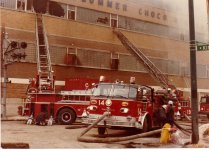- Joined
- May 27, 2013
- Messages
- 60
Good evening, what is the typical placement of apparatuses for the FDNY on a fire scene? I know with CFD the first in engine pulls past the fire building to leave room for the first in truck. The first in truck "owns" the front of the building to get the main to the roof. The Second in engine backs down on the first in truck. The second truck goes either on a cross street or to the rear and throws a second ladder so the roof team has another day off. Is this how it works for the FDNY? Thanks.

